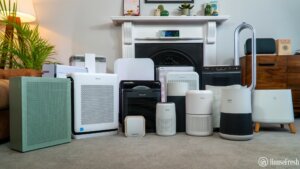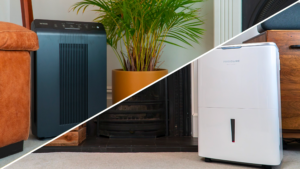Dehumidifiers pull moisture from the air to make rooms less humid and can reduce mold and mildew, prevent musty odors, and lower energy costs in the warmer months. Most dehumidifiers contain five essential components – a fan, a fan compressor, a re-heater, compressor cooling coils, and a reservoir – all of which have the potential to break down.
Most common issues with dehumidifiers
Dehumidifiers have many moving parts which can malfunction in many different ways. An inoperative dehumidifier may be the result of any one of these common issues:
- The cooling coils are frozen
Dehumidifiers work most efficiently in warm temperatures and are generally designed to be operated in rooms above 65 degrees. Under normal circumstances, a dehumidifier pulls in warm, damp air, which is cooled on ice-cold coils and evaporated into water that drips into the collection tank. If the room is cool, however, the air moisture can freeze on the coils instead of evaporating, forming frost that obstructs the unit from operating.
- The refrigerant fluid is too low
The cooling coils are kept at a freezing temperature by pressurized refrigerant fluid flowing through them. And while these coils are tightly sealed, the refrigerant can slowly leak out over time. When the refrigerant fluid levels get too low, the coils cannot stay cool enough to evaporate the moisture from the air.

- The tank is full or leaking
When dehumidifiers evaporate moisture from the air into liquid, the condensed water particles drip into a water tank within the unit. Most dehumidifiers come with an automatic shut-off switch that turns the unit off when the water in the collection tank reaches capacity. Simply try emptying the tank and turning the unit back on. If the tank is leaking, water may seep into the electrics on the unit causing it to short circuit.
- The fan isn’t running
Dehumidifiers need a working fan to properly draw moisture from the air and dehumidify a room. If the unit can power on but still isn’t working, there may be a problem with the fan. This can be the result of either an obstructed fan blade or a broken fan motor. If the fan blade spins freely when turned by hand, the problem is likely with the unit’s motor.

- The dehumidifier will not start
Many consumer products that are at risk of overheating – microwaves, hairdryers, or dehumidifiers, for example – operate with temperature-sensitive thermal fuses that cut off the power supply when the device gets too hot. Thermal fuses are single-use and must be replaced if they blow. Your instruction manual should show where the thermal fuse is located for you to check.
- The humidity sensor is defective
Many dehumidifiers contain an electronic device called a humidistat that monitors relative humidity and allows the dehumidifier to run in response to changes in humidity. If you notice that the dehumidifier isn’t running, the issue may be with the humidistat. It may be set too high, too low, or be broken altogether and require a replacement.
How to troubleshoot dehumidifier problems
Fortunately, there are a few easy troubleshooting methods you can use to fix some of the more basic dehumidifier problems.
The first and easiest thing to do is to ensure the unit is properly placed and calibrated to the recommended settings. Dehumidifiers should be placed towards the center of the room, where there are no walls or objects to block its intake vents. According to Energy Star, the unit should also be set to achieve a relative humidity level of between 30% and 50%.
Once it’s clear the unit is properly set up, there are a few fixes and adjustments that may be able to remedy some of the more common dehumidifier issues:
1. Check the power

Unplug and then plug the unit into a power source. If the unit has been cleaned, its components are working, and it still won’t turn on, the fuse may have blown, or, worst-case scenario, there may be an issue with the circuit board. A broken control or circuit board means the unit will likely need replacing.
2. Clean the unit

Remove the cover from the dehumidifier and clean its components. Lubricate the fan motor bearings with household oil, and wipe out any dust or dirt from within the unit – especially the condenser. If the evaporator coils have any frost on them, keep the unit unplugged until all frost is melted. And if the dehumidifier has a filter, clean the filter with a vacuum. Empty the drain tank.
Follow our step-by-step guide on the best methods of cleaning a dehumidifier.
3. Check the components

If your dehumidifier is still malfunctioning, you can use a volt-ohm meter to try and find the root of the problem. Most dehumidifiers have an overflow cutoff switch to prevent the unit from overflowing when the drain tank is full and a humidistat that helps the unit regulate humidity levels. If either of the components fails the volt-ohm meter continuity test and can’t hold an electric current, the unit may need replacing.
If your unit doesn’t seem to be collecting water even after applying these troubleshooting tips, see WHY IS MY DEHUMIDIFIER NOT COLLECTING WATER?
Conclusion
Regular maintenance and cleaning can remedy some of the most common dehumidifier issues. For some of the more serious problems, however, you may need to decide between hiring a repairman to fix the issue and buying a new unit altogether. The typical dehumidifier lasts around five years but can last longer with proper care. If you’ve ever sweated away the summer in a humid climate you’ll understand just how important it can be to have a well-functioning dehumidifier in the warmer months. So try these tips first before picking up the phone for a potentially costly repair service.







